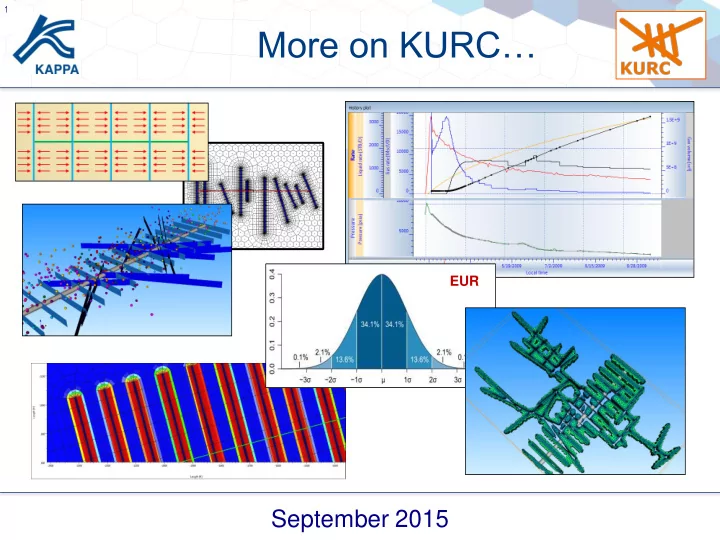

1 More on KURC… EUR September 2015
2 KURC-1 • K APPA U nconventional R esources C onsortium • 28 effective members; 4 more potentially • Data analysis of unconventional plays • Phase 1 from July 2011 to January 2014 • Development of the KURC Application • 3-year exclusivity to consortium members • 150,000 € per participant
3 28 participants (+3?)
4 Budget and expenses
5 KURC application
6 KURC application
7 Main KURC-1 developments 1. Loglog analysis tools (*) 2. Fast analytical / numerical: SRV, trilinear (*) 3. Complex geometries (*) 4. Generalized pseudofunctions (*) 5. Discrete Fractures Networks (DFN) 6. Water flowback 7. Single well statistical EUR 8. Import Microseismic results 9. Import Fracturing software results 10.Confined PVT (*) public in Q2-2016
8 1 – Loglog analysis tools k L w x X f k x N² x X f ²
9 2 – Fast models (e.g. SRV)
10 3 - Complex models
11 4 – Pseudofunctions • Pseudopressure correction • m (p), Z(p) • k(p) • Pseudotime correction • c(p * (t)) • F (p * (t)) • Desorption
12 5 - Analytical / numerical DFN
13 6 – Water flowback
14 7 - Statistical EUR EUR
15 8 – Import from microseismics
16 9 – Import from fracturing sft.
17 10 - Confined PVT • Eagle Ford Oil 1600.0 1200.0 11 components Pressure (psia) Confinement = 10 nm pore radius 800.0 Conventional Validated against CSM models 10 nm 400.0 7.80E-02 0.0 10 nm 0.0 200.0 400.0 600.0 800.0 Viscosity (cp) Temperature ( o F) Conventional 7.40E-02 7.00E-02 0 500 1000 1500 2000 Pressure (psia)
18 2015 extension: KURC-2 • KURC-1 membership as pre-requisite • Topics discussed with KURC-1 members • From January 2015 to December 2016 • 50,000 € for KURC-1 member • 200,000 € for new members (incl. KURC-1)
19 KURC-2 workflow Constrain DFN realizations to interference times U.A. History match Simulation model Forecast DFN Flow mech. + I.S. Fracture + confined PVT simulation + geomechanics Microseismics
20 Main KURC-2 developments 1. Multiple well interferences in DFN’s 2. Fast Marching methods for DFN’s 3. Complex well schedules (*) 4. 3-D DFN’s 5. Stochastic DFN’s from Microseismics 6. Connection to Geomechanics software 7. Enhanced permeability regions 8. Adapted multiphace wellbore model for CSG
21 1 – DFN interferences
22 2 – Fast Marching FMM Interference times DFN realizations Constrain DFN realizations to interference times FMM History match DFN realizations Simulation models
23 3 – Complex well schedules • Simulate water injection period prior to production • Assumption : Inject in pre-existing fracture planes, with Fc(P) curves Start production from perturbed initial {P, S} fields Evaluate flowback
24 4 – 3D DFN’s WIP
25 5 – DFN from Microseismics 3D
26 6 – Geomechanics Flow module (with pressure – dependent k and ) … time k, P T0 T1 T2 Geomechanical module At the end of each exchange time increment : • Mechanical module reads in new pore pressures • Mechanical module calculates new stresses and induced deformations • Mechanical module (or flow module) computes new permeability/porosities from the knowledge of strains/effective stresses • Flow module reads in the new flow properties and use it in computations for the next time increment
27 7 – Enhanced k regions
28 8 – CSG wellbore model from Justin Knight and Tim Whittle, BG
Recommend
More recommend